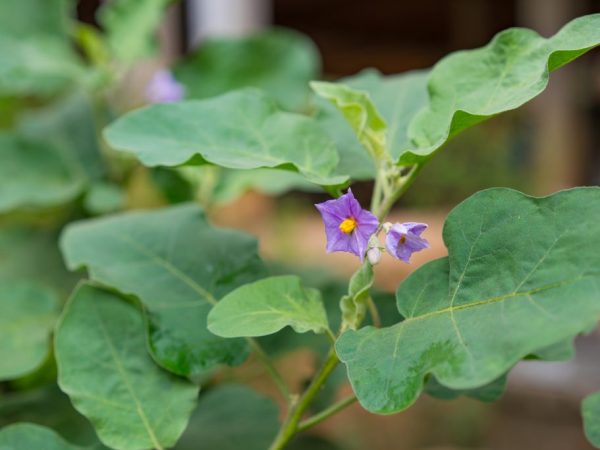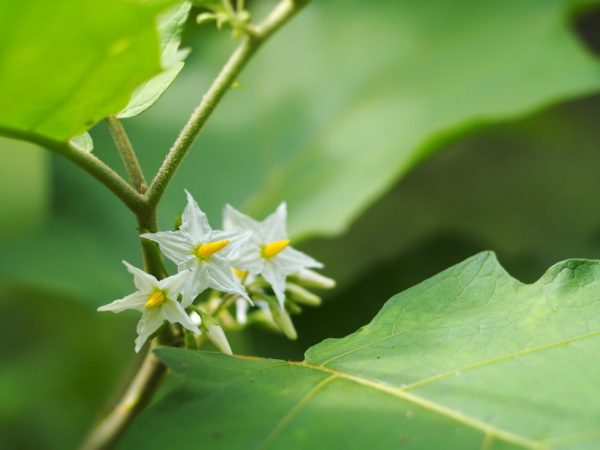Eggplants are not tied during flowering
In horticultural practice, it often happens that eggplants do not set during flowering, although before that the plants developed well. There are many factors that lead to the problem. They consist in improper care. This usually happens when growing vegetables in greenhouse conditions.

Eggplants are not tied during flowering
Reasons for the absence of ovaries
Since eggplant is a capricious culture, it is necessary to provide it with appropriate conditions, excluding all unfavorable factors.
Unsuitable drop-off location
If the plants that are planted nearby will create shade, this threatens with poor ovary formation. Therefore, you should not plant next to trees and other tall crops. Thickened plantings can also create shading. Then the bushes will take the light into each other.
Unsuitable temperature conditions
Eggplants are thermophilic. The optimum temperature at which they grow well should be at the level of 25-27˚С. At rates of 15-18˚C, the bushes stop developing. If they are set at 32 ° C and above, the fruits are not formed. Sharp temperature changes have a bad effect on the formation of vegetables.
Unsuitable soil
In order for the crop to give a high yield, it is advisable to plant on fertile, drained land with a neutral pH level. Clay and podzolic soils are unacceptable for it, the high density and acidity of which does not allow the earth to warm up. Under these conditions, eggplants do not tie well.
Improper watering
Well-moistened soil promotes the formation of a large number of flowers, high fruiting. Watering should be sparse, but abundant. The soil should be moist up to 50 cm deep. A decrease in the number of ovaries and their shedding can provoke frequent watering.
Excess fertilizer

Eggplants tie well with proper feeding
When gardeners are feeding eggplants that respond well, it is important to keep track of the nutrient supply. If you overdo it with nitrogen, plants will begin to actively increase the green mass to the detriment of the formation of ovaries. There will be very few flowers. Those that are will dry up and fall off over time. Therefore, it is recommended to add nitrogen-containing substances in the correct dosage.
Excess pollen
Most of the bushes are self-pollinated. This is very convenient for greenhouse conditions. But it often happens that the pollen cannot be transferred to other flowers. The reason is its large amount or high humidity. As it accumulates, the pollen becomes heavy, causing the substance to stick together. The pollination process is disturbed, no ovaries are formed.
Preventive measures
Poor fruit formation can be prevented by observing the following rules:
- Seedlings are planted in a well-lit place.
- Soil analysis is carried out.In the greenhouse, the soil is prepared for planting in this way: 1 part of sod land, 2 parts of humus.
- Correctly form the bush - remove low-quality ovaries and a few leaves that cover the flowers, but not in large quantities. This can disrupt the development of plants. It is also necessary to remove yellowed diseased leaves in time. During the formation of the fruit, the remains of the corolla of the flower are removed, as it rots over time. This will lead to rotting of the vegetable.
- The greenhouse is regularly ventilated. Monitor the temperature readings. To lower them, several frames are raised. At low temperatures at night, the bushes are covered with hay or special material. In order for the soil to warm up well before planting the seedlings, not too rotted manure or compost is laid in prepared trenches in the fall.
- Moisturize the soil correctly. For this purpose, watering is carried out 1 time in 7-10 days, adding 40 liters of water per 1 sq. m. It is also worth saturating the earth with oxygen, so it is regularly loosened.
- To prevent the pollen from drying out, you need to periodically shake it from the flowers. These manipulations will also increase pollination. For varieties that require pollinators, the procedure is done artificially. To do this, use a brush, with the help of which pollen is taken from the mature yellow anthers of the flower. It is applied to the stigma of the pistil of another flower.
- Fertilizers are applied according to a certain scheme. The first feeding is a few weeks after planting (nitrogen-containing products). The second is before the formation of fruits (complex preparations). The third - during fruiting (phosphorus and potash fertilizers).
Eliminating the problem
If the ovaries are not formed naturally, the plants are stimulated with various drugs.
For this purpose, the following means are used: Bud, Gibbersib, etc. These substances contribute to the growth of the culture, since they contain phytohormone in their composition. Plants can produce it themselves, but with the creation of all conditions requiring culture.
If, due to the high content of nitrogen in the soil, eggplants are not tied in the greenhouse, it is necessary to add substances that soften its effect. For this purpose, potash-phosphorus fertilizers are used.
It is also worth inspecting the bushes for pests. The Colorado potato beetle and aphids can eat the flowers and prevent them from setting. Insects are harvested by hand, as the use of chemicals in the greenhouse is unacceptable. Vegetables accumulate harmful substances in large quantities.
Conclusion
In order for the process of growing eggplant to please with a good result, it is worth observing agricultural technology. If the plant blooms, and the ovaries are not formed, it is worth finding out the cause and eliminating it, then the fruiting will be high and of high quality.


